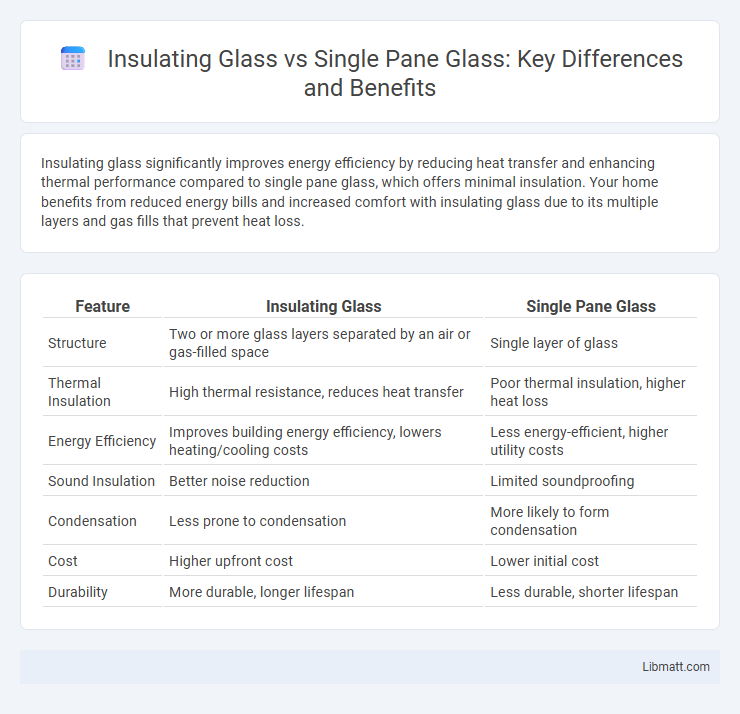Insulating glass significantly improves energy efficiency by reducing heat transfer and enhancing thermal performance compared to single pane glass, which offers minimal insulation. Your home benefits from reduced energy bills and increased comfort with insulating glass due to its multiple layers and gas fills that prevent heat loss.
Table of Comparison
| Feature | Insulating Glass | Single Pane Glass |
|---|---|---|
| Structure | Two or more glass layers separated by an air or gas-filled space | Single layer of glass |
| Thermal Insulation | High thermal resistance, reduces heat transfer | Poor thermal insulation, higher heat loss |
| Energy Efficiency | Improves building energy efficiency, lowers heating/cooling costs | Less energy-efficient, higher utility costs |
| Sound Insulation | Better noise reduction | Limited soundproofing |
| Condensation | Less prone to condensation | More likely to form condensation |
| Cost | Higher upfront cost | Lower initial cost |
| Durability | More durable, longer lifespan | Less durable, shorter lifespan |
Overview: Insulating Glass vs Single Pane Glass
Insulating glass consists of two or more glass panes separated by an air or gas-filled space, significantly enhancing thermal insulation compared to single pane glass, which is a single layer of glass with minimal insulating properties. This design reduces heat transfer, lowers energy consumption, and improves indoor comfort by preventing temperature fluctuations and condensation. Single pane glass offers less energy efficiency and acoustic insulation, making insulating glass a preferred choice for modern, energy-conscious building designs.
Construction Differences
Insulating glass consists of two or more glass panes separated by a spacer filled with air or inert gas, creating a thermal barrier that reduces heat transfer. Single pane glass is a single layer of glass without any layers or insulating gas, resulting in higher heat loss and lower energy efficiency. The multiple layers and sealed air space in insulating glass significantly enhance insulation compared to the simple construction of single pane glass.
Thermal Performance Comparison
Insulating glass significantly outperforms single pane glass in thermal performance by reducing heat transfer through its dual or triple layers combined with gas fills and low-emissivity coatings, which enhance energy efficiency. Your energy bills decrease as insulating glass minimizes heat loss in winter and heat gain in summer, maintaining a more stable indoor temperature. Single pane glass lacks these features, resulting in poor insulation and higher energy consumption.
Energy Efficiency Benefits
Insulating glass, also known as double glazing, significantly reduces heat transfer compared to single pane glass, enhancing energy efficiency by maintaining indoor temperatures and lowering heating and cooling costs. The air or inert gas layer between the panes acts as an effective thermal barrier, reducing energy loss up to 50% more than single pane windows. Improved insulation with insulating glass contributes to decreased carbon emissions and a reduced environmental footprint for residential and commercial buildings.
Sound Insulation Capabilities
Insulating glass significantly outperforms single pane glass in sound insulation capabilities due to its dual-layer construction with an air or gas-filled gap that reduces noise transmission. The thicker structure and varying glass thicknesses in insulating glass minimize sound vibrations, making it ideal for noise-prone environments. Single pane glass lacks this layered design, resulting in higher sound transfer and less effective noise reduction.
Cost Analysis: Initial and Long-term
Single pane glass typically has lower initial costs, making it a budget-friendly option for low upfront investment. Insulating glass, while more expensive initially, offers significant long-term savings through enhanced energy efficiency, reducing heating and cooling expenses. Over time, the improved thermal performance of insulating glass offsets its higher price by lowering utility bills and increasing property value.
Maintenance and Durability
Insulating glass features multiple glass layers separated by a sealed air or gas-filled space, significantly reducing condensation and requiring less frequent cleaning compared to single pane glass, which is more prone to dirt buildup and fogging. The superior durability of insulating glass resists cracking and breakage caused by thermal stress, unlike single pane glass that often needs replacement due to its vulnerability to temperature fluctuations. Maintenance costs for insulating glass are lower over time, as its enhanced construction minimizes damage and extends the lifespan of windows, making it a more cost-effective choice in the long run.
Environmental Impact
Insulating glass significantly reduces energy consumption by enhancing thermal insulation compared to single pane glass, which leads to lower greenhouse gas emissions from heating and cooling systems. The improved energy efficiency of insulating glass decreases reliance on fossil fuels, contributing to a smaller carbon footprint and promoting sustainable building practices. In contrast, single pane glass allows higher heat transfer, resulting in increased energy demand and greater environmental impact over the building's lifespan.
Aesthetic and Design Flexibility
Insulating glass offers greater aesthetic and design flexibility compared to single pane glass, enabling the incorporation of multiple panes with varied tints, coatings, and patterns that enhance visual appeal and energy efficiency. Its ability to accommodate customized shapes and sizes without compromising thermal performance supports innovative architectural designs. Single pane glass, while simpler, lacks the versatility to provide advanced decorative options or improved insulation properties that modern building aesthetics demand.
Best Applications for Each Type
Insulating glass, composed of two or more glass panes separated by a gas-filled space, is best suited for energy-efficient buildings, reducing heat transfer and enhancing noise insulation in residential and commercial windows. Single pane glass, being a single layer of glass, is ideal for applications where cost-effectiveness and simple design are priorities, such as interior partitions, greenhouses, and cold climates where insulation is less critical. Insulating glass performs optimally in regions with extreme temperatures, while single pane glass is sufficient for mild climates and non-thermal sensitive environments.
insulating glass vs single pane glass Infographic

 libmatt.com
libmatt.com